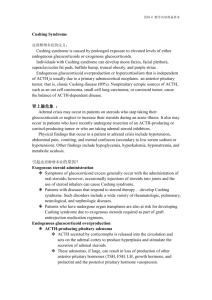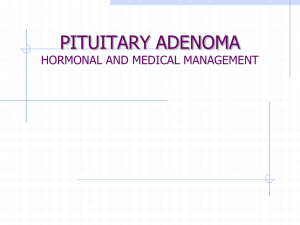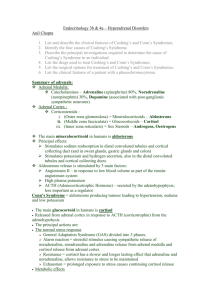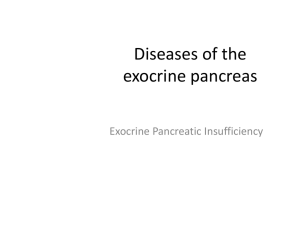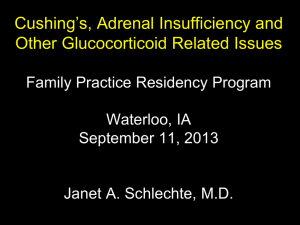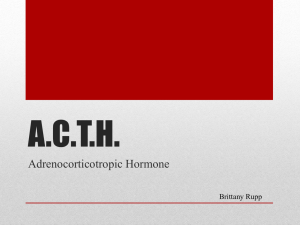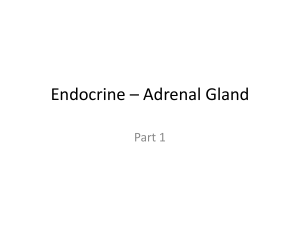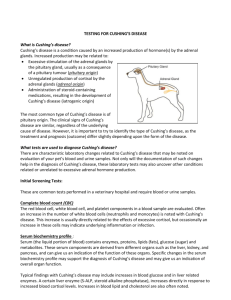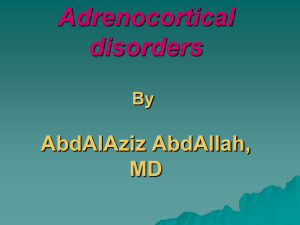Cushing syndrome
advertisement
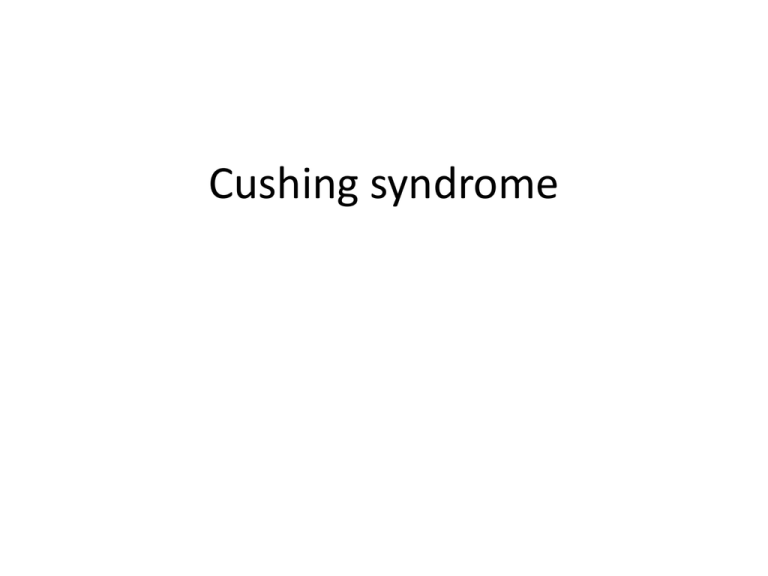
Cushing syndrome • Cushing's syndrome is a clinical features that result from chronic exposure to excess glucocorticoids of any etiology • ACTH-dependent 1. pituitary corticotrope adenoma 2. ectopic secretion of ACTH by nonpituitary tumor • ACTH-independent 1. adrenocortical adenoma 2. adrenocortical carcinoma 3. nodular adrenal hyperplasia 4. iatrogenic (administration of exogenous glucocorticoids ) • The term Cushing's disease refers specifically to Cushing's syndrome caused by a pituitary corticotrope adenoma. Epidemiology • Cushing's syndrome is generally considered a rare disease. • 1–2 per 100,000 population per year. • Cushing's disease is caused by an ACTHproducing corticotrope adenoma of the pituitary (75%) • initially described by Harvey Cushing in 1912 • Cushing's disease more frequently affects women • prepubertal cases is more common in boys. • ectopic ACTH syndrome is more frequently identified in men. • Only 10% of patients with Cushing's syndrome have a primary, adrenal cause of their disease and most of these patients are women. • the medical use of glucocorticoids for immunosuppression, or for the treatment of inflammatory disorders, is the most common cause of Cushing's syndrome. Etiology • Cushing's disease :at least 90% of patients is caused by a corticotrope pituitary microadenoma, often only a few millimeters in diameter. • Pituitary macroadenomas (i.e. tumors >1 cm in size), are found in only 5–10% of patients • usually occur sporadically • very rarely can be found in the context of multiple endocrine neoplasia type 1 (MEN1) Ectopic ACTH production • predominantly caused by occult carcinoid tumors, most frequently in the lung, but also in thymus or pancreas. • Because of their small size, these tumors are often difficult to locate. • Advanced small cell lung cancer • In rare cases medullary thyroid carcinoma or pheochromocytoma ACTH-independent • The majority of patients with ACTHindependent cortisol excess harbor a cortisolproducing adrenal adenoma. • Adrenocortical carcinomas may also cause ACTH-independent disease and are often large, with excess production of several corticosteroid classes. Clinical Manifestations • excess glucocorticoid secretion overcomes the ability of 11-HSD2 to rapidly inactivate cortisol to cortisone in the kidney, thereby exerting mineralocorticoid actions, manifest as : 1. diastolic hypertension 2. Hypokalemia 3. edema • suppression of gonadotropins with subsequent hypogonadism and amenorrhea • suppression of the hypothalamic-pituitarythyroid axis, resulting in decreased TSH (thyroid-stimulating hormone) secretion. • more specific features are : 1. fragility of the skin 2. easy bruising 3. broad (>1 cm), purplish striae 4. signs of proximal myopathy, which becomes most obvious when trying to stand up from a chair without the use of hands or when climbing stairs. • The majority of clinical signs and symptoms observed in Cushing's syndrome are relatively nonspecific and include features such as: 1. Obesity 2. Diabetes 3. diastolic hypertension 4. Hirsutism 5. depression • that are commonly found in patients who do not have Cushing's • Clinical manifestations of Cushing's do not differ substantially among the different causes of Cushing's. • In ectopic ACTH syndrome, hyperpigmentation of the knuckles, scars, or skin areas exposed to increased friction can be observed and is caused by stimulatory effects of excess ACTH and other POMC cleavage products on melanocyte pigment production. • patients with ectopic ACTH syndrome, and some with adrenocortical carcinoma as the cause of Cushing's, may have 1. a more brisk onset 2. rapid progression of clinical signs and symptoms • Patients with Cushing's syndrome can be acutely endangered by 1. deep vein thrombosis 2. pulmonary embolism due to a hypercoagulable state associated with Cushing's. • psychiatric symptoms: 1. anxiety 2. depression 3. acute paranoid psychosis 4. acute depressive psychosis • after cure, long-term health may be affected by : 1. increased risk of cardiovascular disease 2. osteoporosis 3. vertebral fractures Diagnosis • 1- features with a potentially higher discriminatory value • 2 - excluding exogenous glucocorticoid use 1. increased 24-hour urinary free cortisol excretion in three separate collections 2. failure to appropriately suppress morning cortisol after overnight exposure to dexamethasone 3. evidence of loss of diurnal cortisol secretion with high levels at midnight, the time of the physiologically lowest secretion • midnight cortisol level greater than 200 nmol/L (>7.5 μg/dL) indicates Cushing’s syndrome • midnight Salivary Cortisol:a value greater than 2.0 ng/mL (5.5 nmol/L) has a 100% sensitivity and a 96% specificity for diagnosis of Cushing’s syndrome Urinary Free Cortisol Excretion • Normal values are less than 220 to 330 nmol/24 hours (80 to 120 μg/24 hours), Patients should make two or three complete consecutive collections Low-Dose Overnight Dexamethasone Suppression Tests • In normal subjects, the administration of a supraphysiologic dose of glucocorticoid results in suppression of ACTH and cortisol secretion • 1 mg of dexamethasone is given at midnight. • A normal response is a plasma cortisol level of less than 140 nmol/L (<5 μg/dL) between 8 and 9 a.m. • a postdexamethasone cortisol value of less than 50 nmol/L (<2 μg/dL) effectively excludes Cushing’s syndrome. 48-hour low-dose dexamethasone test • plasma cortisol is measured at 9 a.m. on day 0 and again 48 hours later, after administration of dexamethasone 0.5 mg every 6 hours for 48 hours • Using a postdexamethasone plasma cortisol concentration of less than 50 nmol/L (<2 μg/dL) as the cutoff point • this test is reported to have a 97% to 100% truepositive rate and a false-positive rate of less than 1% Differential Diagnosis • plasma ACTH levels are suppressed in cases of autonomous adrenal cortisol excess, as a consequence of enhanced negative feedback to the hypothalamus and pituitary. • patients with ACTH-dependent Cushing's have normal or increased plasma ACTH, • very high levels being found in some patients with ectopic ACTH syndrome. • In patients with confirmed ACTH-independent excess, adrenal imaging is indicated • preferably using an unenhanced CT scan. This allows assessment of : 1. adrenal morphology 2. determination of tumor density in Hounsfield Units (HU), which helps to distinguish between benign and malignant adrenal lesions • For ACTH-dependent cortisol excess an MRI of the pituitary is the investigation of choice 1. it may not show an abnormality in up to 40% of cases because small tumors are below the sensitivity of detection. 2. Characteristically, pituitary corticotrope adenomas fail to enhance following gadolinium administration on T1-weighted MRI images • In all cases of confirmed ACTH-dependent Cushing's, further tests are required for the differential diagnosis of pituitary Cushing's disease and ectopic ACTH syndrome. • most pituitary corticotrope adenomas still display regulatory features, including residual ACTH suppression by high-dose glucocorticoids and CRH responsiveness. • ectopic sources of ACTH are typically resistant to dexamethasone suppression and unresponsive to CRH • if there is any other reason for doubt, the differential diagnosis can be further clarified by performing bilateral inferior petrosal sinus sampling (IPSS) with concurrent blood sampling for ACTH in the right and left inferior petrosal sinus and a peripheral vein. • An increased central/peripheral plasma ACTH ratio >2 at baseline and >3 after CRH injection is indicative of Cushing's disease, with very high sensitivity and specificity. • the results of the IPSS cannot be reliably used for lateralization (i.e. prediction of the location of the tumor within the pituitary), • If the differential diagnostic testing indicates ectopic ACTH syndrome, then further imaging should include high-resolution, fine-cut CT scanning of the chest and abdomen for lung, thymus, and pancreas. • If no lesions are identified, an MRI of the chest can be considered as carcinoid tumors usually show high signal intensity on T2-weighted images. • Furthermore, octreotide scintigraphy can be helpful in some cases as ectopic ACTH-producing tumors often express somatostatin receptors. • Depending on the suspected cause, patients with ectopic ACTH syndrome should also undergo blood sampling for fasting 1. gut hormones 2. chromogranin A 3. Calcitonin 4. biochemical exclusion of pheochromocytoma Treatment • Overt Cushing's is associated with a poor prognosis if left untreated • In ACTH-independent disease, treatment consists of surgical removal of the adrenal tumor Cushing's disease • treatment of choice is selective removal of the pituitary corticotrope tumor, usually via a transsphenoidal approach. • This results in an initial cure rate of 70–80% • long-term follow-up is important as late relapse occurs in a significant number of patients. • If pituitary disease recurs, there are several options, including 1. second surgery 2. Radiotherapy 3. stereotactic radiosurgery 4. bilateral adrenalectomy very severe Cushing • difficult to control 1. hypokalemia 2. hypertension 3. acute psychosis medical therapy • it may be necessary to introduce medical therapy to 1. rapidly control the cortisol excess during the period leading up to surgery. 2. patients with metastasized, glucocorticoidproducing carcinomas 3. In case of ectopic ACTH syndrome, in which the tumor cannot be located bilateral adrenalectomy • immediate cure • requiring life-long corticosteroid replacement. Oral agents • • • • metyrapone ketoconazole. Mitotane, etomidate can be used In severe cases of cortisol excess, to lower cortisol. It is administered by continuous IV infusion in low, nonanesthetic doses. • Metyrapone inhibits cortisol synthesis at the level of 11-hydroxylase . • Typical starting doses are 500 mg/tid (maximum dose, 6 g) • antimycotic drug ketoconazole inhibits the early steps of steroidogenesis, 200 mg/tid (maximum dose, 1200 mg). • Mitotane, a derivative of the insecticide DDT, is an adrenolytic agent that is also effective for reducing cortisol. • most commonly used in the context of adrenocortical carcinoma, but low-dose treatment (500–1000 mg per day) has also been used in benign Cushing's. After surgery • After the successful removal of an ACTH- or cortisol-producing tumor, the HPA axis will remain suppressed. • hydrocortisone replacement needs to be initiated at the time of surgery and slowly tapered following recovery, to allow physiologic adaptation to normal cortisol levels. • the HPA axis may require many months or even years to resume normal function.
